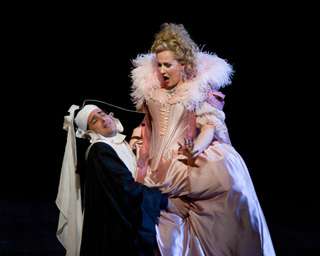|
Back
A Fairy Tale With Fizz New York
The Metropolitan Opera
03/24/2011 - and March 29, April 2, 5, 9, 14*, 18, 21, 2011
Gioachino Rossini: Le Comte Ory
Diana Damrau (Countess Adèle), Joyce DiDonato (Isolier), Juan Diego Flórez (Comte Ory), Stéphane Degout (Raimbaud), Michele Pertusi (The Tutor), Susanne Resmark (Ragonde), Monica Yunus (Alice), Tony Stevenson, Tyler Simpson (Courtiers), Rob Besserer (Prompter)
Metropolitan Opera Chorus, Donald Palumbo (Chorus Master), Metropolitan Opera Orchestra, Maurizio Benini (Conductor)
Bartlett Sher (Production), Michael Yeargan (Set Designer), Catherine Zuber (Costume Designer), Brian MacDevitt (Lighting Designer)

J. D. Flórez, D. Damrau (© Marty Sohl/Metropolitan Opera)
For Rossini’s last comic opera, Le Comte Ory, the road to the Met has been a long one. It took 182 years to get here, to be exact. And its genesis has been rather unusual: this comic gem is a composite of two very different sorts of works: music drawn from Rossini’s own opera, Il viaggio a Reims, and a one act play by Eugène Scribe and Charles-Gaspard Delestre-Poirson. The delectable result is an opera with zany characters, sprightly melodies, and captivating but treacherously difficult bel canto vocal lines. Extraordinary singers are required, and the Met provided three of them: Juan Diego Flórez, Diana Damrau and Joyce DiDonato. (For the tenor and soprano, this production was a reunion; they were last seen here in February 2010 season in La Fille du Régiment.
We first meet Ory living outside the walls of Adèle’s castle disguised as a hermit. He dispenses advice as a sort of medieval agony aunt to the various women left behind by their husbands and lovers who have gone off on the Crusades. Ory’s page, Isolier (Joyce DiDonato), arrives and confides in the Hermit (whom she does not recognize) that he dearly loves Adèle and in order to win her, he will enter the castle disguised as a pilgrim. Ory decides to employ the page’s scheme to his own advantage. At the end of the first act, he is unmasked by his tutor (Michel Pertussi). Although forced to flee the castle, he will not give up. Act two finds him and his men disguised as nuns. They appear at the castle asking for refuge from Comte Ory who they say is pursuing them. This ruse is also discovered, and, at the end, it is Isolier who wins Adèle’s affection, and the two presumably live happily ever after.
Flórez as the conniving Ory is irrepressible and irresistible. His antics turn the usual operatic premise on its head. For whether an opera is tragic or comic, it’s usually the baritone who pursues the soprano and tries to thwart her romance with the tenor. In this case, however, it’s the tenor who is up to no good. And when he is foiled, the soprano falls happily into the arms of the mezzo soprano (In a trouser role of course!)
In this bel canto repertoire, Flórez is virtually without peer. He targeted impossibly high notes like a marksman with laser-like accuracy. And his technique is so secure that these feats appeared to be effortless. He is also a charmer with a fine sense of comedy. His mincing walk when dressed as a nun brought the house down, without his having to sing a note.
Diana Damrau was an enchanting Adèle – alternately dizzy and determined yet always full of passion. Her first act aria, in which she confides in the hermit was a masterpiece of overstatement and of glorious singing. What high notes. What phrasing. What lovely vocal color. After hearing her confession, Ory cynically prescribes a love affair. Just to clear away the competition, he also tells her to stay away from Isolier.
Joyce DiDonato as Isolier has a smaller role than the other two, but if any one of them could be said to steal the show, it was DiDonato with her luminous wine-colored voice, even tone, and elegant phrasing. She is a fine actress and so good in trouser roles; even her walk was that of a young man as she strode about the stage. As I watched and listened to her, I remembered the emotional depth she gave to Rosina in her performance last season in Rossini’s Il Barbiere di Siviglia. (Read here).
As Ory’s friend Raimbaud, Stéphane Degout, who appeared as a moving Pelléas earlier this season. (Read here), showed that he is as adept at comedy as he is at tragedy. His warm voice seemed to hold a twinkle as he abetted his friend’s schemes. Michele Pertusi as the tutor was the classic basso buffo, blundering in and trying unsuccessfully to spoil all the fun.
This production marks director Bartlett Sher’s third production for the Met since 2006. His first, Il Barbiere di Siviglia, also with Florez and Damrau, was a great success. In his spare Barbiere, the extension of the stage to surround the orchestra pit created an intimacy between the singers and audience. Although both productions relied on stage gimmicks and physical comedy, the overall production was less effective here. Both productions experimented with space. In Barbiere the stage came out to meet us through the use of a passerelle. In Comte a similar sense of artifice was achieved through the cliché of a play within a play, which seemed in contrast to place an extra layer of separation between audience and singers. Other distracting gimmicks were employed, most notably the return of Rob Bessemer in the non-singing role of a slightly sinister stagehand, termed the prompter in the program. The costumes by Catherine Zuber added a sense of fun. They were gorgeously colored, primarily in peaches and pinks, and also full of exaggerated fairy tale touches. I especially enjoyed the variety of hats – from turbans to wimples to stovepipes and everything in between.
The Met Orchestra under Maestro Benini captured much of the grace, elegance and sheer exuberance of Rossini’s marvelous score. It all added up to an enchanting evening at the Met.
Arlene Judith Klotzko
|